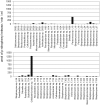Reduction of soybean meal non-starch polysaccharides and α-galactosides by solid-state fermentation using cellulolytic bacteria obtained from different environments
- PMID: 22984557
- PMCID: PMC3439416
- DOI: 10.1371/journal.pone.0044783
Reduction of soybean meal non-starch polysaccharides and α-galactosides by solid-state fermentation using cellulolytic bacteria obtained from different environments
Abstract
Soybean meal (SBM) is an important protein source in animal feed. However, the levels of SBM inclusion are restricted in some animal species by the presence of antinutritional factors (ANFs), including non-starch polysaccharides (NSPs) and α-galactosides (GOSs). The aim of this study was to reduce the soybean meal NSPs and GOSs by solid-state fermentation (SSF) using a combination of cellulolytic bacteria isolated from different environments (termites, earthworms, corn silage and bovine ruminal content). To analyse the key enzymatic activities, the isolates were grown in minimal media containing NSPs extracted from SBM. The selected bacterial strains belonged to the genera Streptomyces, Cohnella and Cellulosimicrobium. SSF resulted in a reduction of nearly 24% in the total NSPs, 83% of stachyose and 69% of raffinose and an increase in the protein content. These results suggest that cellulolytic bacteria-based SSF processing facilitates SBM nutritional improvement. In addition, the use of fermented SBM in animal diets can be recommended.
Conflict of interest statement
Figures





References
-
- Choct M, rsjant-Li Y, McLeish J, Peisker M (2010) Soy Oligosaccharides and Soluble Non-starch Polysaccharides: A Review of Digestion, Nutritive and Anti-nutritive Effects in Pigs and Poultry. Asian-Australasian Journal of Animal Sciences 23: 1386–1398.
-
- Francis G, Makkar H, Becker K (2001) Antinutritional factors present in plant-derived alternate fish feed ingredients and their effects in fish. Aquaculture 199: 197–227.
-
- Karr-Lilienthal LK, Kadzere CT, Grieshop CM, Fahey GC (2005) Chemical and nutritional properties of soybean carbohydrates as related to nonruminants: A review. Livestock Production Science 97: 1–12.
-
- Huisman MMH, Schols HA, Voragen AGJ (1998) Cell wall polysaccharides from soybean (Glycine max.) meal. Isolation and characterisation. Carbohydrate Polymers 37: 87–95.
-
- Knudsen KEB (1997) Carbohydrate and lignin contents of plant materials used in animal feeding. Animal Feed Science and Technology 67: 319–338.
Publication types
MeSH terms
Substances
LinkOut - more resources
Full Text Sources
Other Literature Sources

